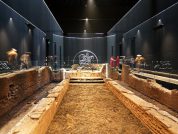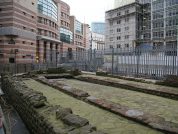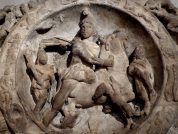London Mithraeum
The London Mithraeum, also known as the Temple of Mithras, in London was a Roman temple dedicated to the god Mithras, who was an important deity in the Roman Empire. The temple was discovered in Walbrook, a street in the City of London, during a building’s construction in 1954, it was them relocated 100m to allow continues building.
History of the London Mithraeum
The Temple of Mithras was an important site for the worship of the god Mithras, who was often associated with the sun and was a patron of soldiers and merchants. The temple was used for private ceremonies and rituals by members of the Mithraic cult, which was a secretive and exclusive organization that was only open to men.
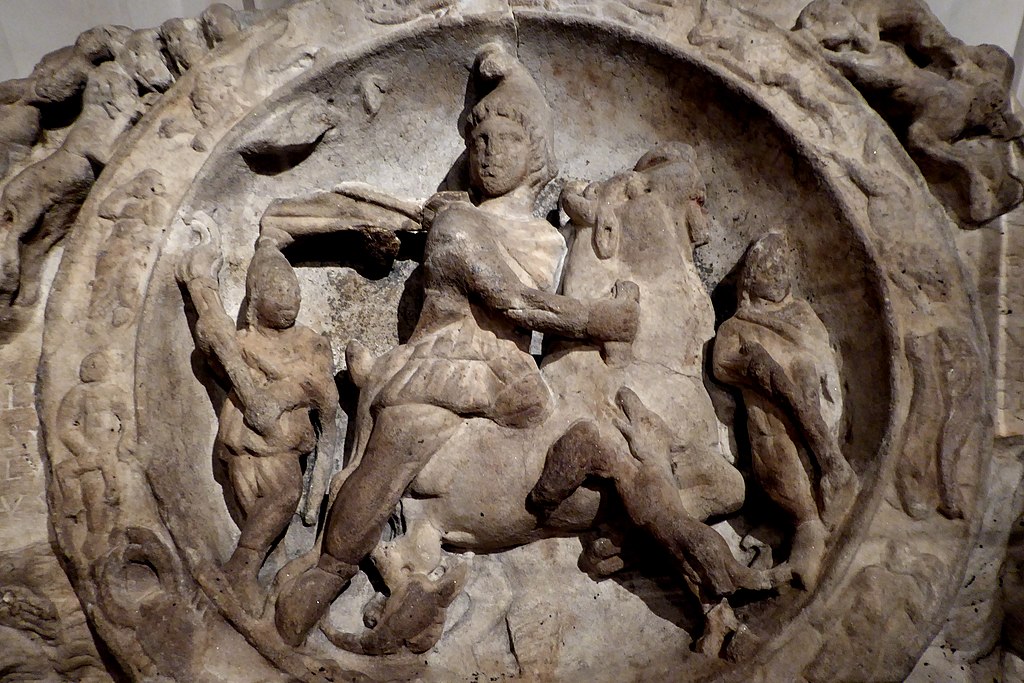
The temple was richly decorated with statues, reliefs, and frescoes that depicted scenes from the mythology of Mithras. The most famous feature of the temple was a large relief depicting the god Mithras in the act of killing the astral bull, the Tauroctony that was as central to Mithraism as the Crucifixion is to Christianity. On it Mithras is accompanied by the two small figures of the torch-bearing celestial twins of Light and Darkness, Cautes and Cautopates, within the cosmic annual wheel of the zodiac. The relief had the following inscription:
RIB 3 - Dedication to Mithras
Ulpius Silvanus, emeritus of the Second Legion Augusta, paid his vow enlisted at Orange.
VS
SILVA
NVS
FAC
TVS
ARAV
SIONE
EMERI
TVS LEG
II AVG
VOTVM
SOLVIT
A emeritus was a time-expired soldier, equivalent to veteranus.Arausio: Colonia Iulia Secundanorum, founded by Julius Caesar with veterans of the Second Legion.factus: interpreted by Mommsen as ‘made a veteran’, but the usual word would be missus. It has also been taken to mean ‘initiated’ into some Mithraic grade, but, if this were so, the grade should be mentioned. miles factus with the consular date is used by vigiles (ILS 2163), and by legionary veterans (ILS 2300, 2301, Apulum, Dacia), of their original enrolment. The London inscription mentions Arausio with no other details. It seems best to regard the action here recorded as the original recruitment of Ulpius Silvanus, which may well have occurred at Arausio, the Second Legion colony. Addenda from RIB+add. (1995): Birley Review, 228, translates factus Arausione as ‘initiated at Orange’, noting that Legion II Augusta had no special tie with Arausio (its Second Legion was Legion II Gallica, cf. AE 1952, 44); but factus in this sense is unparalleled.
The temple was constructed around AD 240, during the height of the Roman Empire. The Roman temple, when it was originally built, would have stood on the east bank of the now covered-over River Walbrook, a key freshwater source in Roman Londinium. The original Mithraeum was built partly underground, recalling the cave of Mithras where the Mithraic epiphany took place. The Temple consisted of a series of rooms and chambers that were accessed by a narrow staircase. The temple was relatively small, measuring about 18 meters long and 8 meters wide.
When the building ceased to be used as a mithraeum, the head and hand from a large statue of Mithras, along with parts from other cult statues, were placed in a pit inside the temple near to the entrance. The temple was rededicated, probably to Bacchus, in the early fourth century.
The other inscriptions found here were:
RIB 2 - Dedication to the Mother Goddesses
To the Mother Goddesses the district restored (this shrine) at its own expense..
VICINIA DE SVO RES[...]
Haverfield points out that it might have come originally from abroad, but there seems to be no reason to doubt its Romano-British origin.vicinia: although CIL viii 14743 shows that Vicinia was a personal name, it seems better to interpret it as ‘district’, evidently without a qualifying adjective, on the analogy of CIL xiii 3652 (Genio viciniae).
RIB 4 - Dedication to Mithras and the Invincible Sun
For the welfare of our August Emperors and most noble Caesar¹ to the god Mithras and the Invincible Sun² from the east to the west.
[...]
[...] INVICTO
[... .] AD [...]ENTEM
- I am inclined to assign a date between AD307 to AD310, biased towards the latter. During this time the Roman world was ruled by the tetrarchy of Galerius, Maxentius and Constantine, while their fourth colleague Maximian was replaced by Licinius in 308. In AD310 Galerius appointed a fifth Caesar to replace himself in the east, Maximinus Daia, who may be the ‘noble Caesar’ mentioned in this inscription. Galerius himself died in 311.
- Sol Invictus was a pseudonym of Mithras.
This marble comes ‘probably from the Greek Islands, and is similar to that from Thasos
RIB 5 - Dedication to the Divinity of the Emperor
To the Divinity of the Emperor the province of Britain (set this up).
PROV[...]
BRITA[...]
For the use of the formula Numen Caesaris Augusti in provincial worship as early as Augustus see CIL xii 4333 (ILS 112) Narbo. How the identity of the emperor concerned was indicated is not now evident; either a portrait-statue or some further text would have been needed. In literature Caesar Augustus means the reigning emperor. For its use to denote Claudius see CIL vi 5539 (ILS 1786) Rome, and to denote either Claudius or Nero see CIL vi 8943 (ILS 1838) Rome, CIL x 5056 (ILS 977) Atina.
RIB 3002 - Altar to Jupiter Optimus Maximus (?)
For Jupiter Best and Greatest, Aquilinus freedman of the Emperor, and Mercator and Audax and Graecus, restored (this) [temple] collapsed from age.
[...] VẸTVS
[.]ATE COṆḶABSVM
ẠQVILINVS AVG ❦
LIB ET MERCATOR
ET AVDAX ET GRAEC ❦
RESTITVER
1. […] M. The enlargement of this letter, and the space to left and right, indicate that it concludes an abbreviated dedication. Altars dedicated to Jupiter are so frequent that I O M is the likeliest restoration, even if it implies that his temple in the provincial ‘capital’ had fallen down. To the left of M there is a diagonal chisel cut which, while too shallow to be part of the second stroke of the letter A, might be the tail of a centrally placed leaf stop; this would imply that there were only two letters in the first surviving line. In that case either [DEO] | [I(NVICTO)] M(ITHRAE) or [MATRI] | [D(EVM)] M(AGNAE) would be possible. 3. [vetust]ate conlabsum. See note to RIB 3001, line 10. 4–5. Aug(usti) lib(ertus). G is badly damaged, and seems to be followed by the remains of a leaf-stop like that in 6. L has no second stroke (contrast L in AQVILINVS). Imperial freedmen in the provinces administered imperial estates or occupied senior posts in the Procurator’s office; compare Aurelius Marcio, freedman procurator of Britain (CIL iii 348 = ILS 1477 (Phrygia) with A.R. Birley 2005, 328–9), and the imperial freedmen attested at York (RIB 643), near Bath (RIB 179) and perhaps at Lincoln (RIB 3173) and in the Vindolanda Tablets (Tab. Vindol. III, app. 352 back 1). Mercator, Audax and Graecus, whose status is not specified, may have been imperial slaves, junior colleagues of Aquilinus, for which compare Vegetus Montani imperatoris Aug(usti) ser(vus) in London (Britannia 34 (2003), 373, No. 22) and the Caesariani in Tab. Vindol. III, 645.
Discovery of the London Mithraeum
The temple was discovered in 1954 during the construction of a new office building in the City of London. Archaeologists were able to excavate the site and carefully remove the remains of the temple, which were then reconstructed and put on display at a new location nearby.
Visiting the London Mithraeum
Today, the Temple of Mithras is a popular tourist attraction and is open to the public for viewing. It provides a fascinating glimpse into the religious practices and beliefs of the Romans who lived in London nearly 2,000 years ago.
The Mithraeum is spread out over three levels, with the Temple located on the lowest of the three. The other levels feature exhibitions of Roman artefacts and information about the cult of Mithras and how they reconstructed the temple.
Entrance to the temple is timed so that visitors can experience the full installation. While entry is free you may wish to book in advance to guarantee your slot (see website).
Plan of London Mithraeum
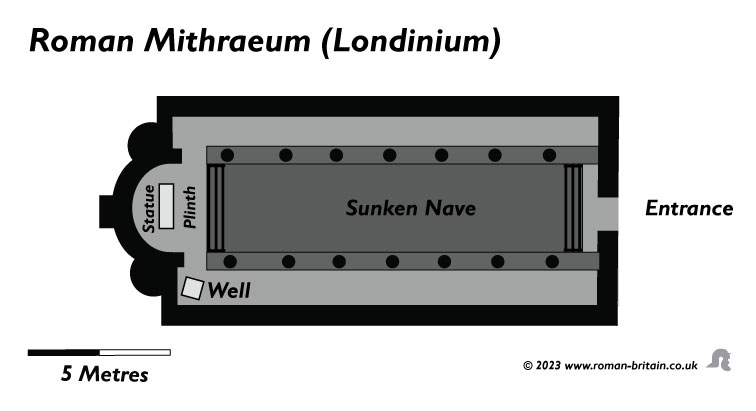
Sites near London Mithraeum
- London (Londinium) Roman Settlement (0 km)
Claudian Auxiliary Fort (AD 43–54), Legionary Fort, Palace and Triumphal Arches - London's Roman Amphitheatre (0 km)
Amphitheatre - Billingsgate Roman House and Baths (1 km)
Roman Houses - Watling Street (3 km)
Roman Road - Highgate Wood Pottery Factory (9 km)
Pottery - Crofton Roman Villa (20 km)
Villa - Brockley Hill (Sulloniacae) Roman Settlement (21 km)
Claudian Auxiliary Fort (AD 43–54), Pottery and Vicus - Little London, Chigwell (Durolitum) Roman Settlement (25 km)
Minor Settlement - Lullingstone Roman Villa (26 km)
Temple Or Shrine and Villa - Ewell (26 km)
Major Settlement
